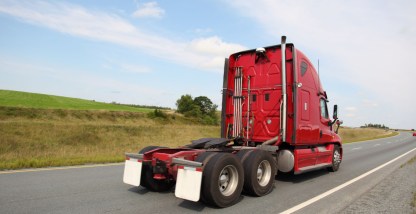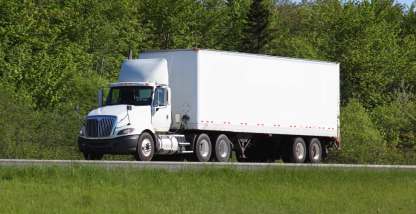Ready to learn how to become an owner-operator? Or are you ready to venture out on your own? Maybe a friend or relative has enjoyed being a driver.
Whatever’s motivating you to start your own trucking business, it’s important to understand a few things.
To help you better understand the ins and outs of becoming a successful owner-operator, we’re assembled this comprehensive guide. In it, we’ll cover everything you need to know about becoming a successful owner-operator.
Who is an owner-operator?
The Owner-Operator Independent Drivers Association (OOIDA) answers the question, “who is an owner-operator” with this definition:
“An owner-operator is a business owner who owns a tractor and on other occasions, a trailer or fleet of trailers.”
Trucking owner-operators are independent freight transport drivers who run a transportation business with their own vehicles. They can also lease out their services while using their own trailers.
Owner-operators manage the day-to-day operations of their business. A trucking owner-operator may act as a driver and an employer at the same time.
Owner-operator vs. independent contractor vs. company driver
Owner-operators have businesses attached to their names and can operate under their authority. This means they can lawfully deliver cargo on their own without being hired by a company.
An owner-operator’s duties may include:
- Loading and unloading their vehicles
- Identifying routes
- Planning and scheduling pickups and deliveries
- Transporting goods as per the contract terms
- Vehicle maintenance and repairs
- Keeping tax records
- Securing licenses and insurances, etc.
Owner-operator vs. independent contractor
All trucking owner-operators are independent contractors. However, not all independent contractors are owner-operators.
Independent contractors are drivers who enter agreements with carriers. Carriers grant them operating authority and guarantee loads for the entire contract period.
Contractors are not owner-operators. Instead of owning commercial vehicles, they lease them from the contracting carrier company. Unlike company drivers, contractors aren’t employees. They don’t receive the same benefits company drivers do. In exchange for the authority and guaranteed hauls, independent contractors often give a portion of their revenues to the carriers. It’s also part of their agreement,
Owner-operator vs. company driver
Company drivers don’t own the commercial vehicles they drive. They’re hired drivers who operate commercial vehicles for a carrier company. The company provides the truck. It also pays for the vehicle acquisition, insurance, maintenance, and repairs.
Benefits of being a trucking owner-operator
Working as owner-operators makes many of them beam with pride. It’s a rewarding business venture for many. Here are some of the benefits of being an owner-operator.
- Acquiring your preferred vehicles and equipment
Some company drivers share vehicles and aren’t assigned their own rigs. Owner-operators are different. They retain full control of the vehicles they acquire. They’re able to use them however they like.
2. Increased control over your income
Trucking owner-operators can earn up to $221,000 per year.
If you can hustle, stay on top of industry trends, and negotiate, then owning a trucking business may be for you. As an independent owner-operator, you’ll have more control over your income and scaling your business.
3. Being your own boss
Being your own boss and the freedom that comes with it is a big deal to many drivers. You don’t need to contest for bonuses, insurance, and salary increases. You also don’t need to request permission for ride-alongs, such as with family members and pets.
Being an owner-operator creates flexibility in your on-duty and off-duty hours. As your own boss, you can travel or spend more quality time with your family. Especially if you reach your target profit ahead of schedule.
4. More opportunities to widen your network
When you own your trucking company, you’ll benefit from ample networking opportunities. People will get to know you as an owner-operator and keep you in mind for possible business partnerships.
Being an owner-operator also comes with challenges. Start-up expenses. Finding loads. Paying the bills. Ensuring compliance. It’s all part of life as an owner-operator.
How to become an owner-operator
The following five-step guide will walk you through the most important areas of becoming a successful trucking owner-operator.
Step 1: Self-evaluate and figure out what you want to achieve
Before anything else, ask yourself what your long- and short-term goals are for starting your own business. This assessment could include thinking about the following questions:
- Are you financially ready to run your own trucking business?
- Do you have a method in place for consistently closing deals?
- What does your current network look like? Do you have enough contacts to lean on if you need help?
Other points for consideration include:
- Your physical health. Can you be on the road for long periods of time?
- What about your family life and home time?
- How knowledgeable are you when it comes to road regulations?
It helps to have previous driving experience. Company drivers with three to five years of experience make the best candidates for owner-operators. They’ve already developed a feel for the industry.
Step 2: Get your DOC and MC numbers
To become a driver-operator, you need to acquire the USDOT and MC numbers to operate legally. If you already have a U.S. Department of Transportation number, your next move is to secure an MC number.
Being in the business also requires you to be amply covered by health and truck insurance. Visit the FMCSA insurance page to get the details of what kind of insurance you need.
The trucking industry is heavily regulated. Your transition from being a truck driver to an owner-operator can easily depend on whether or not you’re complying with road regulations.
In December 2017, the ELD mandate was implemented by the FMCSA. The federal rule requires non-exempt CMVs to install FMCSA-registered electronic logging devices.
Motive’s Vehicle Gateway is an all-inclusive solution that helps keep drivers and fleets compliant.
The Vehicle Gateway offers compliance and fleet management tools that are vital in helping with:
- Optimizing your trucking operations
- Minimizing operational costs
- Reducing administrative burden and paperwork
Step 3: Minimize expenditures
As a trucking owner-operator, you’re focused on growing and maximizing profits. You need a strategy that increases revenue while minimizing operational expenses.
Large expenses may include:
- Vehicle insurance
- Fuel
- Compliance with various regulations
- Vehicle maintenance/repair
There’s a lot you can do to reduce operational costs.
For example, to minimize fuel expenditures, stay within the 65 MPH speed limit instead of going faster. According to studies, you can improve your fuel efficiency by as much as 27% by driving at 65 mph instead of 75 mph.
Additionally, vehicle idling and poor driving behavior may also lead to fuel wastage and expenses.
The Motive Vehicle Gateway automatically detects poor driving habits and critical safety events. Reducing unsafe habits such as hard braking and hard cornering will help you improve road safety, minimize potential liabilities, and increase fuel efficiency.
If you operate in Canada, don’t forget to check out the complete guide to the Canadian ELD mandate.
Step 4: Get the right truck for the best price
The state of your finances will play an essential part in the acquisition of your trucking equipment.
As a trucking owner-operator, you can either lease or buy your truck and trailer outright, which would require a lump sum of cash or acquire your assets through bank financing.
Take your time looking for the best truck deal. Also, look for a bank with a low-interest rate.
It is also worth mentioning that having a solid credit score helps with better interest rates and banks willing to work with you.
The following are factors that may affect your interest rates:
1. Your credit history
An excellent credit rating will help you obtain the lowest interest rates. Financial institutions look at your records to assess your credit risk.
2. Permanent address
A decisive factor that will work for you is if you are a longtime resident of a specific address. Banks believe people who have permanent homes also pay better.
3. Stable job background
Borrowers who show a stable job history are generally seen as a lower liability. Job-hopping, on the other hand, can send the wrong signal to your possible financiers.
The three points above (and other intangibles) are considered during your credit risk review.
There are other ways to fund the purchase of your truck outside of a bank. Here are a few:
- Captive lending institutions
Truck equipment manufacturers own these companies. They are often more receptive to lending to new trucking owner-operators because they are in the business of selling trucks.
- Commercial lending institutions
Used truck dealers may refer you to commercial lending institutions. These finance companies are not necessarily affiliated with truck manufacturers, but certain ones cater to the trucking industry.
Step 5: Understanding the golden equation
Think of your day-to-day operations with this equation:
Revenue per mile – Cost per mile = Gross revenue – Taxes = Net profit
Lower your variable costs as much as possible so your business can turn in a profit. There are several ways you can go about doing this:
1. Find the quickest and shortest route
A faster or shorter route can help minimize fuel consumption.
2. Check your vehicle’s health frequently to avoid severe maintenance issues
Address your vehicle’s maintenance problems as soon as you get wind of them. In theory, this would help reduce costs before the issue gets worse.
3. Reduce vehicle idling
When a truck idles for an hour it consumes about a gallon of fuel. Be mindful of when the engine is turned on and for how long. There are also ways to track this with Motive’s Vehicle Gateway.
4. Drive safely and install a dashcam
Make sure that you are doing your best to avoid possible road accidents. Installing a dashcam can help you prove whether or not you were at fault. It may help to get you exonerated and even lower your insurance premiums.
How to find owner-operator jobs
Landing lucrative projects, loads, and clients are some of the most crucial tasks of an owner-operator.
Learn how to find owner-operator jobs using the strategies below.
1. Establish yourself as a dependable driver
If you want to score high-paying freights, be trustworthy and provide excellent customer service. Clients favor consistently reliable drivers. Ensure you ship your loads on schedule and maintain favorable partnerships with your clients, fleet managers, and other people you’ll work with.
Forging these solid relationships even increases your chances of being the go-to driver of your clients.
Remember: positioning yourself as a dependable driver takes time and effort, but this eventually results in steady workloads and increasing revenue.
2. Use load boards
A load board is an online marketplace that lets shippers, owner-operators, and brokers post and discover freights for hauling in real-time. Load boards are great places to start as they get your wheels rolling as soon as possible.
When transacting with brokers on that virtual marketplace, you have the advantage to tell them your location and dictate the routes you want to take.
Getting shippers from load boards usually makes for short-lived, transactional relationships. To bag longer-term clientele, you should reach out to companies with frequent loads or build long-term working relationships with your existing clients.
3. Find high-ticket trucking clients with regular shipments
Seek credible shippers that request regular delivery, pay well and on time, and have freight lanes matching your ideal routes. It’s also better to find shippers with quick-pay offers.
You can find these ideal clients from other industry niches and their local federation chapters in your area. Examples include pharmaceuticals, auto dealerships, food retail stores, the US Government (one of the largest shippers in the country), and more.
Take time to assess these local industries. Concentrate your efforts on the underserved companies and see how you can fulfill their cargo transport needs. Most of these associations’ membership lists with contact details are also publicly available, so use them to list your prospects.
Once you have them, call or email their fleet managers and set up a meeting — preferably in person. Next, check out how they pick their carriers and drivers and uncover ways to set yourself among their top preferred partners.
Becoming an owner-operator: next steps
Owning your own business requires talent and hard work. Talk to your friends and peers. Ask about their experience, the job’s challenges.
Learn more about the business of being an owner-operator:
- The process of becoming an owner-operator: What you need to know
- New owner-operators: 7 ways to reduce your expenses
To succeed as an owner-operator, you’ll need the right tools. Like these Motive products:
- Motive ELD to ensure compliance with the ELD mandate
- AI-Powered Smart Dashcam for Fleets to help increase fleet safety and ensure you have video evidence that may be used for driver exoneration.








